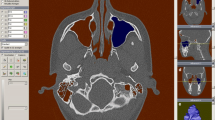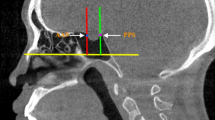Abstract
This study evaluated three-dimensional (3D) volumetric image reconstructions to identify morphological differences of the clivus and sphenoid sinus on computed tomography (CT) scans of Chiari malformation type I (CMI) and control subjects. Axial CT images of adult females for 30 CMI subjects and 30 age and body mass index (BMI) matched controls were used for this retrospective study. 3D volumetric reconstructions were created from the bone windows of axial data following image registration for position and orientation correction of the head. The volume, surface area, linear dimensions and spatial position in the x, y, and z-axes were computed separately for the clivus and the sphenoid sinus for each subject. Eleven parameters were found to be significantly different between CMI subjects compared to controls. Most notably, clivus volume was reduced by 31% on average in CMI subjects. In contrast, we found that the sphenoid sinus volume was 38% greater on average in CMI subjects. Moreover, clivus length, height, width, and thickness were 3.7, 2.8, 3.0 and 9.4 mm reduced, respectively, in CMI subjects. This is the first study to demonstrate cephalometric differences in the 3D morphology of the clivus and sphenoid sinus between CMI subjects and controls.






Similar content being viewed by others
References
Alkofide, E. A. The shape and size of the sella turcica in skeletal class I, class II, and class III Saudi subjects. Eur. J. Orthod. 29(5):457–463, 2007.
Alperin, N., J. R. Loftus, C. J. Oliu, A. M. Bagci, S. H. Lee, B. Ertl-Wagner, B. Green, and R. Sekula. Magnetic resonance imaging measures of posterior cranial fossa morphology and cerebrospinal fluid physiology in Chiari malformation type I. Neurosurgery 75(5):515–522, 2014; (discussion 522).
Aydin, S., H. Hanimoglu, T. Tanriverdi, E. Yentur, and M. Y. Kaynar. Chiari type I malformations in adults: a morphometric analysis of the posterior cranial fossa. Surg. Neurol. 64(3):237–241, 2005; (discussion 241).
Badie, B., D. Mendoza, and U. Batzdorf. Posterior fossa volume and response to suboccipital decompression in patients with Chiari I malformation. Neurosurgery 37(2):214–218, 1995.
Budu, V., C. A. Mogoanta, B. Fanuta, and I. Bulescu. The anatomical relations of the sphenoid sinus and their implications in sphenoid endoscopic surgery. Rom. J. Morphol. Embryol. 54(1):13–16, 2013.
Chiari, H. Ueber Veränderungen des Kleinhirns infolge von Hydrocephalie des Grosshirns1. DMW-Deutsche Med. Wochenschr. 17(42):1172–1175, 1891.
Chiari, H. Über Veranderungen des Kleinhirns, des Pons und der Medulla oblongata infolge von kongenitaler Hydrocephalie des Grosshirns. Denkschr. Akad. Wiss, Wien. 63:71–116, 1895.
Dagtekin, A., E. Avci, E. Kara, D. Uzmansel, O. Dagtekin, A. Koseoglu, D. Talas, and C. Bagdatoglu. Posterior cranial fossa morphometry in symptomatic adult Chiari I malformation patients: comparative clinical and anatomical study. Clin. Neurol. Neurosurg. 113(5):399–403, 2011.
Dufton, J. A., S. Y. Habeeb, M. K. Heran, D. J. Mikulis, and O. Islam. Posterior fossa measurements in patients with and without Chiari I malformation. Can. J. Neurol. Sci. 38(3):452–455, 2011.
Eppelheimer, M. S., J. R. Houston, J. R. Bapuraj, R. Labuda, D. M. Loth, A. M. Braun, N. J. Allen, S. Heidari Pahlavian, D. Biswas, A. Urbizu, B. A. Martin, C. O. Maher, P. A. Allen, and F. Loth. A retrospective 2D morphometric analysis of adult female Chiari Type I Patients with commonly reported and related Conditions. Front. Neuroanat. 12:2, 2018.
Fernandes, Y. B., P. F. Perestrelo, P. Y. Noritomi, R. N. Mathias, J. V. Silva, and A. F. Joaquim. 3-D simulation of posterior fossa reduction in Chiari I. Arq. Neuropsiquiatr. 74(5):405–408, 2016.
Fernandes, Y. B., R. Ramina, C. R. Campos-Herrera, and G. Borges. Evolutionary hypothesis for Chiari type I malformation. Med. Hypotheses 81(4):715–719, 2013.
Fischbein, R., J. R. Saling, P. Marty, D. Kropp, J. Meeker, J. Amerine, and M. R. Chyatte. Patient-reported Chiari malformation type I symptoms and diagnostic experiences: a report from the national Conquer Chiari Patient Registry database. Neurol. Sci. 36(9):1617–1624, 2015.
Fooanant, S., S. Angkurawaranon, C. Angkurawaranon, K. Roongrotwattanasiri, and S. Chaiyasate. Sphenoid sinus diseases: a review of 1442 patients. Int. J. Otolaryngol. 2017:9650910, 2017.
Ford, J. M., and S. J. Decker. Computed tomography slice thickness and its effects on three-dimensional reconstruction of anatomical structures. J. Forensic Radiol. Imaging 4:43–46, 2016.
Furtado, S. V., K. Reddy, and A. S. Hegde. Posterior fossa morphometry in symptomatic pediatric and adult Chiari I malformation. J. Clin. Neurosci. 16(11):1449–1454, 2009.
Houston, J. R., M. S. Eppelheimer, S. H. Pahlavian, D. Biswas, A. Urbizu, B. A. Martin, J. R. Bapuraj, M. Luciano, P. A. Allen, and F. Loth. A morphometric assessment of type I Chiari malformation above the McRae line: a retrospective case-control study in 302 adult female subjects. J. Neuroradiol. 45(1):23–31, 2018.
Hwang, H. S., J. G. Moon, C. H. Kim, S. M. Oh, J. H. Song, and J. H. Jeong. The comparative morphometric study of the posterior cranial fossa: what is effective approaches to the treatment of Chiari malformation type 1? J. Korean Neurosurg. Soc. 54(5):405–410, 2013.
Karagoz, F., N. Izgi, and S. K. Sencer. Morphometric measurements of the cranium in patients with Chiari type I malformation and comparison with the normal population. Acta Neurochir. (Wien). 144(2):165–171, 2002; (discussion 171).
Khalsa, S. S. S., N. Geh, B. A. Martin, P. A. Allen, J. Strahle, F. Loth, D. Habtzghi, A. U. Serrano, D. McQuaide, H. J. L. Garton, K. M. Muraszko, and C. O. Maher. Morphometric and volumetric comparison of 102 children with symptomatic and asymptomatic Chiari malformation Type I. J. Neurosurg. Pediatr. 21(1):65–71, 2018.
Koo, T. K., and M. Y. Li. A guideline of selecting and reporting intraclass correlation coefficients for reliability research. J. Chiropr Med. 15(2):155–163, 2016.
Machinis, K., J. Pantel, I. Netchine, J. Leger, O. J. Camand, M. L. Sobrier, F. Dastot-Le Moal, P. Duquesnoy, M. Abitbol, P. Czernichow, and S. Amselem. Syndromic short stature in patients with a germline mutation in the LIM homeobox LHX4. Am. J. Hum. Genet. 69(5):961–968, 2001.
Massey, S. L., J. Buland, S. Hauber, J. Piatt, J. Goraya, E. Faerber, and I. Valencia. Acute VI nerve palsy in a 4 year-old girl with Chiari I malformation and pontomedullary extension of syringomyelia: case report and review of the literature. Eur. J. Paediatr. Neurol. 15(4):303–309, 2011.
Miki, T., H. Ito, H. Kawai, and T. Nakanishi. Chiari malformation (type I) associated with bilateral abducens nerve palsy: case report. No shinkei geka. Neurol. Surg. 27(11):1037–1042, 1999.
Milhorat, T. H., M. W. Chou, E. M. Trinidad, R. W. Kula, M. Mandell, C. Wolpert, and M. C. Speer. Chiari I malformation redefined: clinical and radiographic findings for 364 symptomatic patients. Neurosurgery 44(5):1005–1017, 1999.
Milhorat, T. H., M. Nishikawa, R. W. Kula, and Y. D. Dlugacz. Mechanisms of cerebellar tonsil herniation in patients with Chiari malformations as guide to clinical management. Acta Neurochir (Wien). 152(7):1117–1127, 2010.
Neelakantan, A., and A. K. Rana. Benign and malignant diseases of the clivus. Clin. Radiol. 69(12):1295–1303, 2014.
Nguyen, V., and M. Varacallo. Neuroanatomy, Cranial Nerve 6 (Abducens). Treasure Island: StatPearls, 2019.
Nishikawa, M., H. Sakamoto, A. Hakuba, N. Nakanishi, and Y. Inoue. Pathogenesis of Chiari malformation: a morphometric study of the posterior cranial fossa. J. Neurosurg. 86(1):40–47, 1997.
Ozer, C. M., K. Atalar, I. I. Oz, S. Toprak, and C. Barut. Sphenoid sinus in relation to age, gender, and cephalometric indices. J. Craniofac. Surg. 29(8):2319–2326, 2018.
Prevention, C.F.D.C.A. About Adult BMI. Volume 2018: Centers for Disease Control and Prevention, 2017.
Richards, P. S., A. Bargiota, and R. J. M. Corrall. Paget’s disease causing an Arnold-Chiari type 1 malformation. Am. J. Roentgenol. 176(3):816–817, 2001.
Sekula, Jr, R. F., P. J. Jannetta, K. F. Casey, E. M. Marchan, L. K. Sekula, and C. S. McCrady. Dimensions of the posterior fossa in patients symptomatic for Chiari I malformation but without cerebellar tonsillar descent. Cerebrospinal Fluid Res. 2:11, 2005.
Shah, A., and A. Goel. Clival dysgenesis associated with Chiari type 1 malformation and syringomyelia. J. Clin. Neurosci. 17(3):400–401, 2010.
Shaikh, A. G., and F. F. Ghasia. Neuro-ophthalmology of type 1 Chiari malformation. Expert Rev. Ophthalmol. 10(4):351–357, 2015.
Smith, B. W., J. Strahle, J. R. Bapuraj, K. M. Muraszko, H. J. Garton, and C. O. Maher. Distribution of cerebellar tonsil position: implications for understanding Chiari malformation. J. Neurosurg. 119(3):812–819, 2013.
Speer, M. C., D. S. Enterline, L. Mehltretter, P. Hammock, J. Joseph, M. Dickerson, R. G. Ellenbogen, T. H. Milhorat, M. A. Hauser, and T. M. George. Review article: Chiari type I malformation with or without syringomyelia: prevalence and genetics. J. Genet. Couns. 12(4):297–311, 2003.
Stokovic, N., V. Trkulja, I. Dumic-Cule, I. Cukovic-Bagic, T. Lauc, S. Vukicevic, and L. Grgurevic. Sphenoid sinus types, dimensions and relationship with surrounding structures. Ann. Anat. 203:69–76, 2016.
Strahle, J., K. M. Muraszko, J. Kapurch, J. R. Bapuraj, H. J. Garton, and C. O. Maher. Natural history of Chiari malformation Type I following decision for conservative treatment. J. Neurosurg. Pediatr. 8(2):214–221, 2011.
Stroke, N.I.O.N.D.A. Chiari Malformation Fact Sheet. Volume 2019: National Institute of Neurological Disorders and Stroke, 2018.
Tajima, T., T. Hattori, T. Nakajima, K. Okuhara, J. Tsubaki, and K. Fujieda. A novel missense mutation (P366T) of the LHX4 gene causes severe combined pituitary hormone deficiency with pituitary hypoplasia, ectopic posterior lobe and a poorly developed sella turcica. Endocr. J. 54(4):637–641, 2007.
Taştemur, Y., V. Sabanciogullari, M. Sönmez, M. Cimen, and I. Saik. The relationship of the posterior cranial fossa, the cerebrum, and cerebellum morphometry with tonsiller herniation. Iran. J. Radiol. 14(1):1–11, 2017.
Ting, E. Y. S., F. Ting, G. S. Chia, Y. K. Ong, and V. Chong. Chapter 4—imaging in endoscopic endonasal skull base surgery. In: Skull Base Imaging, edited by V. Chong. Elsevier: Amsterdam, 2018, pp. 65–82.
Urbizu, A., M. A. Poca, X. Vidal, A. Rovira, J. Sahuquillo, and A. Macaya. MRI-based morphometric analysis of posterior cranial fossa in the diagnosis of Chiari malformation type I. J. Neuroimaging 24(3):250–256, 2014.
Yonetsu, K., M. Watanabe, and T. Nakamura. Age-related expansion and reduction in aeration of the sphenoid sinus: volume assessment by helical CT scanning. AJNR Am. J. Neuroradiol. 21(1):179–182, 2000.
Yushkevich, P. A., J. Piven, H. C. Hazlett, R. G. Smith, S. Ho, J. C. Gee, and G. Gerig. User-guided 3D active contour segmentation of anatomical structures: significantly improved efficiency and reliability. Neuroimage 31(3):1116–1128, 2006.
Acknowledgments
The authors would like to thank Conquer Chiari for providing funding for this research work. The authors would also like to acknowledge the contribution of Dr. Philip Allen for his support of interpreting the statistical results and Jiyoon Kim for her support in the segmentation process. Finally, we want to thank the individuals who donated their CT scans for this research.
Conflict of interest
All authors declared that they have no conflict of interest
Ethical Approval
This study was submitted and approved by the local Institutional Review Boards of The University of Akron and the Cleveland Clinic Foundation.
Author information
Authors and Affiliations
Corresponding author
Additional information
Associate Editor Stefan M Duma oversaw the review of this article.
Publisher's Note
Springer Nature remains neutral with regard to jurisdictional claims in published maps and institutional affiliations.
Rights and permissions
About this article
Cite this article
Nwotchouang, B.S.T., Eppelheimer, M.S., Bishop, P. et al. Three-Dimensional CT Morphometric Image Analysis of the Clivus and Sphenoid Sinus in Chiari Malformation Type I. Ann Biomed Eng 47, 2284–2295 (2019). https://doi.org/10.1007/s10439-019-02301-5
Received:
Accepted:
Published:
Issue Date:
DOI: https://doi.org/10.1007/s10439-019-02301-5




